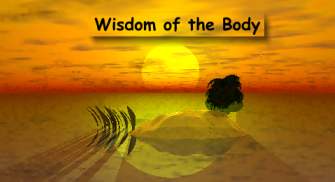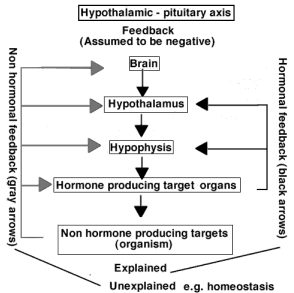
 |
Medical Hypotheses (1999) 52 (5), 447- 449
Abstract
Modern medicine still fails to explain processes that operate in self
healing diseases. We may thus distinguish between two kinds of processes that
operate in the body: explained, and unexplained. The latter operate in self
healing diseases, and are either ignored by medicine or called placebo. Hippocrates
regarded such processes as healing force of nature and the task of the physician
was to assist the healing force. Unexplained processes in physiology were coined
by Starling and Cannon, Wisdom of the Body (WOB). This concept is applied here
for a rational treatment of processes involved in health and in disease.
WOB is an attribute of live organisms. It directs growing plants toward
sunshine, guides amebas to avoid noxious agents, and determines the behavior
of higher animals. It is essential for individual survival and was molded by
Natural Selection. During evolution WOB encountered all diseases and knows how
to heal itself, and anticipates all diseases. The main task of the WOB is to
maintain health, and improve its qualify. It controls processes in the body
so as to make them healthier. The WOB has its own language and should be considered
when examining the patient.
Medicine in the grip of technology
Although health is the main concern of medicine its exact meaning is not
at all clear. Medicine is more concerned with non-health, known as disease.
Yet not every disease may be regarded as non-health. Many young adults have
in their arteries arteriosclerotic plaques without any apparent health deterioration.
Are these plaques non-health and should they be treated? Obviously health and
disease are not complementary. How then to handle diseases that do not impinge
upon health? Sophisticated technology reveals slight aberrations that in the
past were unknown, e.g., mild hypertension, a slightly elevated blood sugar,
or breast cancer precursor lesions. Are these aberrations real diseases? Modern
technology confronted medicine with a new problem, how to deal with aberrations
in a patient that feels healthy?
Technology revealed also that diseases evolve. They start as small aberrations
without clinical manifestations, while the patient feels healthy. Advancing
technology reveals more and more pre-clinical aberrations, and medicine lacks
clear guidelines for dealing with them. To wait until they become more pronounced
is generally regarded as malpractice. Medicine presumes that the traditional
guideline "primum non nocere" results from ignorance and helplessness, and is
not advised. Yet technological innovations endow this concept with a new meaning,
e.g., "Do not harm, and don't interfere until the aberration ripens for treatment".
The medicine of Homo Faber
Medicine adopted also the philosophy of technology, according to which
physico-chemical laws control the organism in health and in disease. It is the
philosophy of "Homo Faber" that applies laws of machines to the organism. A
small aberration is therefore a malfunction, that should be corrected whenever
found. True, the patient with a minute arteriosclerotic plaque feels healthy,
yet his sensations are deceiving him, and he has to be told that he is ill.
While in the past sickness drove the patient to seek help, today he learns from
his physician that he is ill, and he is advised to be periodically screened
for malfunctions.
Healing force of nature
Medicine has always been blessed with self healing diseases, e.g., flu,
common cold, or minor aberrations that are cured by the organism. Self healing
cannot be explained by physico-chemical laws. It does not fit the philosophy
of Homo Faber and is therefore ignored. Hippocrates called it the healing force
of nature (vis medicatrix naturae). The role of the physician was to assist
the healing force during treatment. Guyenot regarded the organism as "first
among physicians" (1,2). Modern medicine attributes such notions to ignorance.
Yet ignorance prevails also today. Technology revealed that the organism is
extremely complex, and that physico-chemical laws still fail to tackle the complexity
of life. By abandoning the healing force, modern medicine ignores an important
facet of the healing process, known as placebo. A medical dictionary defines
placebo as "any dummy medical treatment; originally, a medicinal preparation
having no specific pharmacological activity against the patient's illness."
(3). Suppose that you gave aspirin to a patient with a flu, and he gets better.
The theory of medicine, (here pharmacology) fails to explain why he gets better,
and calls the aspirin effect placebo. Yet the effect is real, and beneficial.
Hippocrates would attribute it to the healing force of nature. Modern medicine,
on the other hand sees it as a useless dummy, since lacking specific pharmacological
activity. In other words, medicine ignores this effect since it cannot be explained
by the pharmacological theory (4). We may thus distinguish between two kinds
of processes that operate in the body: 1. Processes that are explained by the
medical theory, and 2. Unexplained processes, or placebo.
While processes of the first category are explained by physico-chemical
laws, unexplained processes will always evade such reductionistic approach.
They and their interactions are overwhelmingly complex, and cannot be reduced
further.
Wisdom of the Body
Unexplained processes intrigued two renown physiologists, E. H. Starling,
and W. B. Cannon. Starling realized that even if all physiological processes
in the body were understood, we still could not explain how they are controlled.
This knowledge he attributed to the wisdom of the body (WOB). This was also
the title of Cannon's physiology book, which introduced the notion of homeostasis
(5). WOB accounts for all processes that operate in the body, explained and
unexplained (6).
WOB is an attribute of live organisms. It directs growing plants toward
sunshine, guides amebas to avoid noxious agents, and determines the behavior
of higher animals. It is essential for individual survival and was molded by
Natural Selection. According to Darwin's theory of Natural Selection, each live
being on earth is best qualified to live on this planet otherwise it would have
been replaced by a more qualified. In other words the wisdom of today's live
forms is most adequate for their survival in the present circumstances. From
the medical point of view, since agents causing disease are part of the environment
that "selects the best fitted organisms", during evolution WOB encountered all
diseases and knows how to heal itself. It anticipates all diseases, and is therefore
"the first among physicians" (1).
The hypothalamic-hypophyseal axis
The relationship between explained and unexplained processes is illustrated
on the hypothalamic-pituitary axis (Fig. 1). Black arrows, represent explained
processes, e.g. hormonal feedback. Gray arrows, represent the effect of the
organism on the axis, which is generally unexplained. Since all components maintain
homeostasis, hormonal treatment involves explained as well as unexplained processes.
The negative feedback of cortisone is mediated by two routes, explained, e.g.,
pituitary, and hypothalamus (black arrows), and unexplained (gray arrows). In
the above flu patient, the beneficial role of aspirin might be mediated among
other via the gray arrows, with "no specific pharmacological activity" like
any placebo. The WOB concept serves here for a rational evaluation of unexplained
processes in healing. Whatever aspirin does to a flu patient, it is mediated
by the WOB that directs diseases in their course, and the role of the physician
is to assist it.

The language of the WOB
Unconscious messages inform the WOB on the functioning of the organism,
e.g., metabolic homeostasis, extra-pyramidal system, neuro-vegetative system,
immune system, and cell turnover. Some messages are transmitted to our consciousness,
e.g., hunger, thirst, pain, and feeling ill. Other messages are regarded as
synonyms, e.g., malaise, lassitude, prostration, weariness, weakness an tiredness.
However they belong to an intricate language that ought to be explored. Even
seemingly obvious messages, like headache confuse medicine. In a hypertensive
patient, headache is meaningful to medicine, since being explained by the elevated
blood pressure. The same headache when occurring in daily life is meaningless
since not accounted for by explained processes (7). Since the WOB is involved
in health and disease, its language should be taken seriously when examining
the patient.
Disease
An interrogation of the WOB would reveal that many aberrations that are
regarded by medicine as diseases, are not regarded as such by the WOB, otherwise
it would have transmitted to the consciousness a sense of being ill, or at least
a feeling of distress. According to Leriche: "Health is life lived in the silence
of the organs" (1). We may thus distinguish between two kinds of diseases: 1.
Aberrations in a healthy (or silent) organism, and 2. Aberrations in an organism
that feels sick. Both are regarded by medicine as genuine diseases. To the WOB
only the second type is a real disease. Who is right? Medicine views the organism
as indolent. It has to be told, rescued and screened. Such efforts may be iatrogenic,
and contrary to the nature of WOB. Here lies the main therapeutic difficulty
of modern medicine. It does not act in agreement with the WOB.
Health
The main task of the WOB is to maintain health, and improve its qualify.
It controls processes in the body so as to make them healthier. This control
is even more intricate than the control of homeostasis itself. It is best likened
to the task of a conductor. The orchestra is made of music creating processes
(musicians), and the conductor's task is to improve the performance of the orchestra.
While the conductor aims at aesthetics, the WOB aims at improving health. The
orchestra could play without a conductor, yet its performance would deteriorate.
So does the organism, it is capable of maintaining different homeostatic levels,
each endowed with a different health quality. For instance at one occasion the
organism (or its homeostasis) might be tired, or it may be hungry, and even
feeling ill. As the WOB attempts to drive the organism (homeostasis) to the
healthiest condition, it instructs the tired organism to rest, the hungry organism
to seek food, and the ill organism to seek medical help.
Both tasks, that of the conductor and that of the WOB, cannot be expressed
by physico-chemical laws. When attending his patient, the physician actually
interferes with the task of the WOB. He ought therefore attempt to integrate
in the "orchestra of the organs", which he may achieve only by understanding
the WOB (8).
References
1 Canguilhem G. Le normal et le pathologique. translated
into English by Fawcett CR, Cohen RS.Zone Books New York 1991.
2 Zajicek G. Th normal and the pathological. Cancer J. 1994;7:48-49.
3 Dorland's Medical Dictionary. 27 th Edition. WB Saunders Co Philadelphia,
1988.
4 Zajicek G. The placebo effect is the healing force of nature. Cancer J.
8;2:44-45.
5 Cannon WB. "The Wisdom of the Body". Norton, New York, 1932.
6 Zajicek, G: Wisdom of the Body. Cancer J. 1994; 7: 212-213.
7 Zajicek G. The language of the wisdom of the body. The Cancer J.1995; 8:291-292.
8 Zajicek. Normative medicine, Med. Hypotheses. 1995;45:331-334.